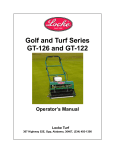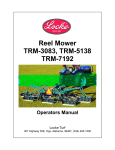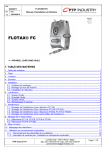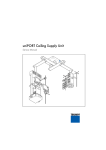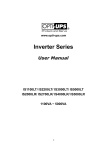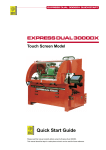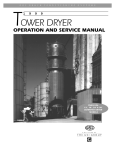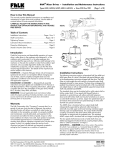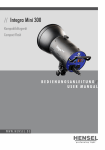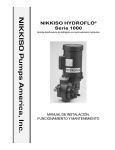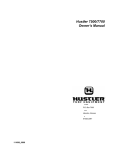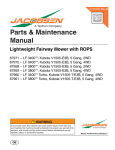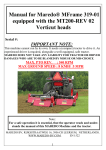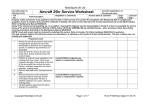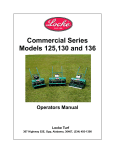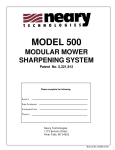Download Transportable Reel Mowers Operator`s Manual
Transcript
KESMAC Transportable Reel Mowers 3, 5, 7, 9 and 11 Gang Mowers Fairway Mowers Vertical Mowers Operators Manual Manual Part No. KM99026. Rev. 05/07 KESMAC Inc. 23324 Woodbine Avenue, Keswick Ontario Canada L4P 3E9 Tel (905) 476-6222 Fax (905)-6744 Web Site www.Kesmac.com [email protected] KESMAC Transportable Reel Mowers FOREWORD The Operator’s Manual must be kept on the machine at all times. The Manual is provided to give the Owner/Operator the correct information on the safe operating procedures, minor repairs and the maintenance of the machine. Important features and specifications are included to help you operate your Kesmac mower safely and efficiently. All Kesmac machines are tested and inspected before leaving the factory to ensure that all safety devices and safety decals are in place. Do not operate the machine if any safety device or decal is damaged or missing. IMPORTANT Follow the recommended operating practices, and the service/maintenance procedures, as outlined in the manual to ensure continued safe and satisfactory performance of the mower. Questions relating to service or repair, that may be beyond the scope of this manual, should be directed to your Kesmac Dealer or to the factory Service Department. Kesmac has a policy of continued product improvement and development, and reserves the right to change design and specifications without notice, or obligation to modify previously manufactured machines. IMPORTANT Record the Serial Number of the machine. It must be quoted when ordering parts or placing a service call to the factory. Manual Part No. KM99026. Rev. 05/07 CONTENTS SAFETY PRECAUTIONS GENERAL SAFETY Before Operating During Maintenance Safety Symbols Safety Decals Operating Conditions 1 2 2 3 3 4 7 DAILY INSPECTION Tires and Wheels Drive Belts & Sheaves PTO Shafts Tongue and Hitch Hydraulic System Guards and Decals Initial Operation Check 8 8 10 11 11 12 12 12 HOOK-UP TO TRACTOR Transport 13 14 HYDRAULIC LIFT OPERATION 16 LIFT CAIN ADJUSTMENT 20 MOWING PROCEDURE Cutting Height Adjustment Reel to Bedknife Adjustment Single point Adjustment 22 23 24 25 VERTICAL MOWER Depth of Cut Adjustment Drive Belts Adjustment Operation 26 26 27 MAINTENANCE Lubrication Chart Gearbox Lubrication Wheel Change – Main Wheel Wheel Change – Out Rigger Wing Kick Springs Main Drive Belts Reel Drive Belts Jackshaft Bearing Replacement PTO Shafts Set-Up 28 30 31 33 35 36 37 38 41 41 SPECIFICATIONS 42 BACKLAPPING UNIT Backlapping Reel & Bedknife Grinding 44 44 46 ELEVEN GANG Optional Castor Wheel 47 LIFT CHAINS Attaching Dimensions TORQUE CHART 48 48 49 SAFETY PRECAUTIONS The correct operating procedures, and strict adherence to recommended service schedules, are important in contributing to the safe operation of the machine and the safety of the operator and others. It is important when carrying out service or repair work on Kesmac Mowers to follow all of the operating and service safety procedures that are outlined in this manual, to ensure your own safety and that of any bystanders. It is not possible to identify all possible situations that may arise that could possibly affect the safety of service personnel or bystanders and the machine, therefore Kesmac cannot list all possible precautions that may prevent accidents. The Owner/Operator, and service personnel, must assume responsibility for their own safety, the safety of others and of the machine, by following all safety instructions, and fully understanding the safe operation of the machine as outlined in the operator’s manual. The operator should at all times be aware of any potential safety hazards, and take corrective action immediately if a dangerous situation should arise. If you do not understand……….ASK Kesmac Inc. will not be responsible for any damages, or claims from damages, arising from the unauthorized modification of its products, or the use of replacement parts that are not genuine Kesmac replacement parts, or parts that do not meet Kesmac Engineering manufacturing specifications. It is recommended that Kesmac products should be serviced, maintained and repaired only by qualified service personnel. 1 SAFETY PRECAUTIONS – General Safety The Operator’s Manual brings to your attention situations that can arise during the safe and routine operation of your Kesmac Mower. It also informs you how to deal with non-routine conditions and situations, and avoid possible injury to yourself or to others. The manual outlines the safe practices that must be followed when operating the mower when it is equipped with standard equipment. Note that attachments which are not specified by Kesmac may affect the safe performance of the machine, and are used at the Owner/Operator’s risk, as they are not supplied or approved by Kesmac Inc. BE A QUALIFIED OPERATOR BY : • Reading and understanding the written instructions in the Operator’s Manual and also on the safety decals on the Mower and the Tractor. • Receiving training on the operation of the Mower and the Tractor. • Asking your equipment dealer or supervisor to explain things you do not understand. • Explain the written instructions in the operator’s manual and on the safety decals to operators who cannot read. BEFORE OPERATING THE MOWER Read this manual and any others supplied with the machine. Check that all safety decals and safety guards are correctly located and are not damaged MAINTENANCE SAFETY Before doing any maintenance or service work : • Due to moving heads, spring loadings, sharp blades, and other potential injury causing factors, exercise caution in the placement of fingers and hands when carrying out adjustments or repairs. • Adjustments or service work must only be done when the Reels are stationary and have been lowered to the ground, the PTO is disengaged and the tractor engine is switched off. (If the tractor is attached to the mower). 2 SAFETY PRECAUTIONS During Maintenance • Use only genuine Kesmac parts. Parts that are not supplied by Kesmac may not meet Kesmac Engineering specifications or standards of manufacture. • The use of parts not approved by Kesmac may result in component failure possibly resulting in an accident and injury to the operator or bystanders. • Relieve pressure in hydraulic systems before attempting to carry out any service work. Failure to observe this precaution may result in serious personal injury. SAFETY ALERT SYMBOL Hazards are identified by this symbol, followed by the Signal words DANGER, WARNING or CAUTION DANGER Indicates an immediate situation which if not corrected or avoided WILL result in death or serious injury. WARNING Indicates a potential hazardous situation which COULD result in death or serious injury. CAUTION Indicates a potentially hazardous situation which MAY result in a minor or moderate injury. 3 The warning /safety Decals are prominently displayed and strategically located on the machine. Check regularly that Decals are not missing, and are easily readable. Do not operate the machine if any of the decals are damaged or missing. It is important that the operator is familiar with the Safety Decals. Do not operate the machine if drugs, alcohol or any medications are being used which can affect alertness or co-ordination. Seek professional advice before operating the machine if in doubt about the side affects from any medication being taken that may put your safety at risk. DECALS. See Pages 5 & 6 also. 4 GENERAL SAFETY Operating Conditions Commercial mowers are subjected to a variety of ground conditions. Mowing machine operators must understand the need to pay constant attention to the changing conditions that they may encounter while operating the machine. These precautionary measures will help in more efficient operation and reduced equipment ‘down time’. IMPORTANT Positive drive PTO Mowers have a powerful cutting action, very little will ‘stop’ them. This type of mower will ‘swallow’ sand, mud, sticks, cans, golf balls and other debris that would ‘stop’ other types of mowers. Contact with such debris will drastically reduce the Blade and Bedknife sharpness and result in a loss of the quality of cut. Contact with debris can also cause damage to, or the brakedown, of the mower. Look after your Mower……and it will look after your mowing. 7 • WARNING Guards are installed by the manufacturer for your protection and that of bystanders. • Do not engage the PTO with the mower reels in their raised, (transport), position. • Do not raise the mower reels when the PTO is engaged. • The PTO must be disengaged and the reels stationary before the mower reel units are raised. • Keep clear of all moving parts. DAILY INSPECTION To enable customers to implement service procedures, and design changes that are recommended to improve the operation and service life of the mower, Service Bulletins are issued by the factory. It is important that Service Bulletin instructions are implemented as soon as possible. IMPORTANT At the end of the workday clean the mower thoroughly. If a pressure washer is used do not direct the high pressure water jet directly at the Bearing Seals, to do so will force water into the bearings and result in bearing failure. TIRES Main and Outrigger. All tires should be visually inspected each day for excessive wear, bulges or any other damage. • Refer to the Tire Sidewall for the recommended operating pressure. • Check the Wheel Lug Nuts for tightness. The Wheel Nuts should be tightened to 90 ft.lb. torque. Pay particular attention to the above if the machine is frequently transported on highways or on rough roads. NOTE Turf tires are not designed for use on highways. MAINWHEEL BEARINGS Mower Units up to Serial No. 73 have Sealed Bearings that do not require lubricating during service. Refer to pages 33, 34 & 35 for service procedure on the revised axle designs, with Cup and Cone Bearings, that are fitted from Serial No. 74 onwards. OUTRIGGER WHEELS Mower Units Serial No. 1 to 73 (and also No.87) have Dual Outrigger Wheels. All machines after No.73 have Single Outrigger Wheels. Dual Outrigger Wheels have a single Roller Bearing pressed into the Wheel Hub, and retained by a Collar at each end of the axle. Cont… 8 DAILY INSPECTION Cont.. OUTRIGGER WHEELS Fig.1 Serial No. Up to 73. Dual Wheels. It is important that the Roller Bearings and Hub Cavity are kept packed with grease. Apply grease daily. IMPORTANT Also check that the Lock Collars at both ends of the Axle are locked to the Axle by the Set Screws Fig.1 Fig.2 Serial No. 74 onwards. Single Wheel. Mowers with the Taper Roller Bearings, (Cup and Cone), do not require daily maintenance. Refer to pages 33, 34 and 35 for service procedure. 9 Fig.2 DAILY INSPECTION DRIVE BELTS AND SHEAVES Fig.3 Check all Drive Belts for signs of cracking, excessive wear, cuts, or stretching. Sheaves must be kept free of debris. Worn Sheaves allow a belt, that has no excessive wear, to ‘bottom out’ in the ‘vee’ groove. A shiny, polished track in the bottom of the ‘vee’ groove is evidence of a badly worn drive belt and/or Sheave. Fig.3 PRIMARY BELTS Fig.4 The Primary Drive Belts are tensioned by spring tensioned ‘idlers’. There should be 1/2 inch deflection of the belt when pressed ‘down’ mid-way between the Sheaves. Increase or decrease the belt tension by adjusting the Belt Idler Adjusting Nut. Fig.4 REEL DRIVE BELTS Fig.5 Check that the Telescopic Arm is free by pulling it ‘up’, it should slide freely against spring pressure. Apply grease to the grease fitting. Fig.5 10 DAILY INSPECTION PTO SHAFT Fig.6 The PTO Shaft must be installed, relative to the tractor, as shown. WARNING Do not operate the machine without the PTO Shaft Shields in place. To do so could result in serious personal injury. Fig.6 The PTO Manufacturers Service Manual is supplied with the machine. It is important that inspection, service and maintenance instructions for the PTO are followed. Grease the PTO daily. TONGUE TUBE Fig.7 Check the nuts and bolts ‘A’ for tightness. Lubricate the Swivel Hitch at grease fitting ‘B’ Fig.7 11 DAILY INSPECTION HYDRAULIC SYSTEM • • • Check all hydraulic fittings, connections and hoses for signs of leaks, damage or wear. Hoses must be routed clear of any moving parts, and secured to prevent ‘rubbing’ to prevent damage. Keep all hydraulic connections clean. Refer to pages 16 to 19 for the hydraulic system diagrams and operation. GUARDS AND DECALS Before starting mowing operations : • Check that all safety Guards are in place and not damaged. • Check that all Safety/Warning Decals are in place, are clean and readable. WARNING Do not operate the machine if any Safety Guards or Safety/Warning Decals are missing or damaged. To do so may result in serious personal injury. INITIAL OPERATION CHECK After the first 10 hours of operation : • • Check all fasteners for tightness. Check the Main Wheel Retainer Bolts. Remove the lower bearing Blocks. Check that the Bearing Retainer Washers are tightly locked by the Retainer Bolts. (Refer to illustrations on pages 34 and 35). If the washer is loose, remove the Retainer Bolt and apply ‘Loctite 242’ to the threads and refit the bolt and washer. Torque the Retainer Bolt to 76 in/lb. Re-assemble the Lower bearing Blocks. IMPORTANT With the Lower Bearing Blocks removed check also that the inner races of the bearings show no signs of turning on the axle shaft. This check should be done at regular service intervals. For main axles with Taper Roller Bearings refer to pages 33 and 34. 12 HOOK-UP TO TRACTOR Fig.8 It is important that the Mower Frame is ‘level’ for the correct set-up for mowing. Connect the Mower Swivel Hitch to the Tractor Draw Bar using an approved Draw Pin. The front and rear Jack Shafts should be the same height from the ground. IMPORTANT Adjust the Swivel Hitch to set the Mower Frame level to the ground. It is removable to allow it to be rotated 180 degrees to increase the adjustment relative to the Tractor Draw Bar. (Optional Ball Hitch also illustrated). IMPORTANT The use of a Draw Bar hung between the 3-Point Hitch Arms is not recommended. Connect the PTO Shaft to the Mower Gearbox and the Tractor Tail Shaft, see Fig.6, and secure the Shields. WARNING The PTO Shields are identified : Tractor End and Mower End. If Shields are missing do not operate the Mower. 13 Fig.8 HOOK-UP TO TRACTOR Connect the Mower ‘Quick Connects’ to the tractor accessory hydraulic connections. Keep the hydraulic connections clean. TRANSPORT WARNING Relieve any hydraulic pressure in the mower hydraulic system before connecting the mower to the tractor hydraulic system. Failure to do so could result in serious personal injury . Fig.9 To relieve pressure in the Mower Hydraulic System press the plunger ‘A’ in the Disconnect, ‘inwards.’ In the mowing mode the Main Wheel Bearings on all models have a service life of approximately 20,000 hours. In the transport mode the bearing service life varies from model to model. For example : WARNING Use a suitable tool or piece of wood, do not use your fingers as this could result in serious injury. Direct the disconnect away from your person. WHEEL BEARING SERVICE LIFE • • • • 11 Gang 9 Gang 7 Gang 5 Gang 500 Hours. 750 Hours 850 Hours. 1400 Hours. CAUTION Maintain the correct tire pressures, as shown on the tire sidewall. Do not tow a Mower that is fitted with Turf Tires on the highway. Fig.9 14 TRANSPORT LOWERING THE REELS LIFTING THE REELS Before ‘lowering ‘ the Reels, position the Mower on level ground. If on a slope face the mower ‘up hill’, this allows the reels to lower evenly on both sides, and prevents damage to the Reel Drives. Check that the transport Safety Chains are un-hooked from the Reels and are in their ‘stowed’ position. IMPORTANT To prevent damage to the Reels do not lower them with the Safety Chains in their transport positions. Do not set the tractor engine RPM too high. Shift the Tractor Hydraulic Control Valve Lever to the ‘DOWN’ position. Return the Control Valve Lever to ‘NEUTRAL’ when all Reels are fully down. CAUTION Check all chains regularly for damage, and that all Shackles are securely wired. Failure to observe this precaution could result in an accident and personal injury 15 Shift the Tractor Hydraulic Control Valve Lever to the ‘UP’ position. Return the Control Valve Lever to ‘NEUTRAL’ when the Reels are fully raised. Re-attach the Safety Chains. TRANSPORT SAFETY CHAINS When transporting or storing the Mower, the Transport Safety Chains must be attached from the Main Lift Arms to the opposite side Wing Reels. CAUTION Do not engage the PTO with the Reels in the raised (transport) position. The PTO must be disengaged and the Reels stationary before the Reels are raised. HYDRAULIC LIFT OPERATION REEL/WING - LIFT SEQUENCE Fig.10. From Serial No. 550. (See Fig.11 for earlier machines) Hydraulic oil pressure to the ‘raise’ circuit lifts the five main reels first, followed by the wing reels and lastly the wing frames. The cylinders are ‘locked up’ by Pilot Check Valves. The Pilot Check Valves are released by pressure on the ‘lower’ side of the hydraulic circuit. REEL/WING - LOWER SEQUENCE Fig.10 Hydraulic oil flow in the ‘LOWER’ circuit is stopped by the Sequence Valve until the wing cylinders are fully extended. Oil pressure is then sufficient to open the Sequence Valve and ensure that the wing frames will ‘LOWER’ first, then the wing reels, followed by the main reels. Pilot Check Valves in the Valve Block remain ‘closed’, until pressure via the return lines ‘opens’ them allowing return oil to escape from the cylinders. This prevents the reels from ‘creeping down’ from the transport position. Restrictors in the wing cylinders prevent the wings from ‘lowering’ too quickly. Fig.10 16 HYDRAULIC LIFT OPERATION REEL/WING - LIFT SEQUENCE Fig.11 Machines up to Serial No. 231. Hydraulic oil pressure to the ‘RAISE’ circuit lifts the five main reels first, followed by the wing reels and lastly the wing frames. The cylinders are ‘locked up’ by Pilot Check Valves. The Pilot Check Valves are released by pressure on the ‘LOWER side of the hydraulic circuit. REEL/WING - LOWER SEQUENCE Fig.11 Hydraulic oil flow in the ‘LOWER’ circuit is stopped by the Sequence Valve until the wing cylinders are fully extended. Oil pressure is then sufficient to open the Sequence Valve and ensure that the wing frames will ‘LOWER’ first, then the wing reels, followed by the main reels. Pilot Check Valves in the Valve Block remain ‘closed’ until pressure via the return lines opens them allowing the return oil to escape from the cylinder. This prevents the reels from ‘creeping down’ from the transport position. A Restrictor in the Check Valves prevents the wings from ‘lowering’ too quickly. Fig.11 17 HYDRAULIC LIFT OPERATION SEQUENCE VALVE SETTING. (7, 9 & 11 Gang only) Fig.12 If the main (center five) reel assemblies start to lower before the wing frames/reels have finished their cycle, the Sequence Valve requires re-setting, as follows : • • • • • • 7 – 9 – 11 GANG ONLY Back-off the Jam-nut. With a 3/16 Allen Key turn the Sequence Valve Adjuster one half turn ‘CLOCKWISE’. Raise the reel assemblies. Start ‘lowering’ the reels until they are fully down. The main reels should not move. Back-off the Sequence Valve pressure adjuster until the main reels start to ‘lower’ when ‘DOWN’ is selected on the Control Valve. Tighten the Jam-nut. NOTE If the main reels do not go ‘DOWN’, the Sequence Valve Adjuster is turned too far ‘CLOCKWISE’. Fig.12 CAUTION If the Wing Frames drop with a ‘BANG’, check that the Kick Springs are not ‘seized-up’ or damaged. See Fig.31. 18 HYDRAULIC LIFT OPERATION SEQUENCE VALVE MANIFOLD, RELIEF VALVE SETTING To prevent damage to the lift linkage if there is a ‘hangup’ of a Lift Chain, a Relief Valve is installed in the Manifold Block to control oil pressure to the Lift Cylinders. The Relief Valve setting prevents excessive oil pressure at the Lift Cylinders at engine ‘idle speed’. Higher ‘idle speeds’ will not increase the ‘lift rate’, this is controlled by Restrictor Orifices in each cylinder. Idle speed settings that are ‘too fast’ increase the oil flow above the Relief Valve setting, negating its protection. RELIEF VALVE SETTING Fig.13 To set the ‘lift rate’ at normal engine ‘idle’ speed : It is recommended that the adjustment is done when the temperature is a minimum 50 deg.F. Operating at below this temperature may require a slightly higher Relief Valve opening pressure. • Remove the Relief Valve Cap. • Turn the Adjuster ‘IN’ ¼ turn at a time, until the mower units lift at a normal rate. • During adjustment oil should be heard passing the Relief Valve, if it is not, the pressure is set too high. 19 Fig.13 LIFT CHAIN ADJUSTMENTS Fig.14 The Lift Chains for the rear outer reels, No’s 4,5,8,9,10 & 11,are fitted with chain adjusters that ensure that the ‘Snubber’ Rollers engage correctly in the catchers. Refer to page 21 for the correct sequence of reel numbering and the Lift Chain locations. REELS 4 AND 5 Fig.15 Before adjusting the Lift Chains on reels No’s 4 and 5, check that the main lift arms work in unison. The chain bolts must be level, relative to each other, in the ‘raised’ and in the ‘lowered’ positions. Check that the Cylinder, when fully retracted, measures 20 1/8 inches from the rod-end Tie Rod Pin to the fixed end Pin. Adjust the Synchronizer Tie Rod to obtain the correct measurement : • Retract the Cylinder. • Back-off the Tie Rod locknuts • Adjust the Tie Rod until the chain bolts are ‘level’. • Extending the Tie Rod rotates the arms C.W. • Retracting the Tie Rod rotates the arms C.C.W. (Continued on following page) Fig.14 Fig.15 20 LIFT CHAINS ADJUSTMENT REELS 4 AND 5 Cont. Fig.15. (page 20) Extend the cylinder and check that the chain bolt heads are level. Extending the Cylinder Rod End Clevis rotates the RH Arm C.C.W. and the LH Arm C.W. Retracting the Rod End Clevis rotates the arms in the opposite direction. Fig.14 and 16. With Reels 4 and 5 ‘raised’, check that the ‘Snubber’ Rollers are located in the main frame ‘catchers’. Shortening the lower inner chains, No. 3, lifts the Reel. Shortening the upper outer chains, No. 4, will pull the Reel ‘inward’. The outer chains should be tight, with the ‘Snubbers’ in their catchers. The inner chain, No. 3, should be snug. Raise the wing frames until the ‘Snubber’ Rollers on Reels No’s. 8 and 9 engage in the ‘catchers’ on the wing frames. The inboard lift chains No. 6, controlling the inboard end of the reel should be tight. The outer chains No. 7, controlling the outboard end of the Reel should be snug. Reels 10 and 11. When the wing frames are fully raised and Reels 8 and 9 are stowed, Reels 10 and 11 will lower into their stowed positions. The inner lift chains, No. 9, should be slack and the outer lift chains No. 8 should be tight CAUTION Exercise caution, keep clear of the Reels units when making adjustments and raising and lowering them. Refer to page 48 for chain attachment point dimensions. Fig.16. Chains No.1, 2 and 5 do not require adjustment. 21 MOWING PROCEDURE CUTTING HEIGHT ADJUSMENT Preferably position the Mower on level ground, if on a slope, face ‘up hill’ to allow the reels to lower evenly and prevent possible damage to the reel drives. Fig.17 For initial set-up of the mowing height : • Position the mower on level ground and lower the reel assemblies. Place a 1 in. thick spacer under the bed-knife. • Back-off the height adjuster lock-nuts, turn each Adjuster until the roller is touching the ground. • Tighten the height adjuster lock-nuts. This will give an approximate mowing height of 1½ in. Match mark the Height Adjuster to the Mower Frame with a ‘dab’ of paint. The ‘Notches’ on the Adjuster are 3/8 in. apart. Adjust the cutting height relative to the match mark and the ‘notches’. Fixed head fairway mowers use the same method, but the front roller is adjusted to ½ to ¾ in. from the ground. CAUTION Do not engage the tractor PTO when the reels are in the raised position. • • • • • • Release all transport locking chains. Lower the reel units to the ground. Engage the PTO at low engine rpm to prevent shock loads to the mower drive train. Select the appropriate tractor gear range, Maxi – mum 5.5 mph. ( 8.9 kph.), at rated PTO speed. Accelerate to max. PTO speed ( 500 to 540 rpm) If operating on rough stoney ground, around ditches, sand traps, terraces for example, reduce the engine rpm, and/or select a lower transmission gear. CAUTION The PTO must be disengaged and the reel blades not rotating before raising the reel assemblies, to prevent damage to the mower drive line. Fig.17 22 CUTTING HEIGHT ADJUSTMENT FAIRWAY. FLOATING HEAD Fig.18 A special tool is available that ensures that each mowing unit cuts at the same height, and also that the Reels and Bed-knives are parallel to each other. To set the cutting height : • Raise the Reels to transport position. Set the front and rear rollers to ‘minimum height’ by releasing the lock-nuts and turning the front and rear Height Adjusters ‘clockwise’. • Set the required ‘height of cut’ ‘A’ with the front Adjusting Screw in the Adjusting Bar. • Position the head of the Adjusting Screw on the Bed-knife Blade. • Tighten the rear Adjusting Screw, against the Bed-knife Holder, until the Adjusting Bar and the Bed-knife are parallel. • Turn the front and the rear Height Adjusters until the front and rear rollers contact the Adjusting Bar. • Tighten the Lock-nuts. Remove Adjusting bar. Follow the above procedure at both ends of the rollers to ensure an even height of cut across the Reel. Each mowing unit must be adjusted using the same method, for all mowing units to cut at the same height. 23 Fig.18 REEL TO BED KNIFE ADJUSTMENT Pre-single point adjustment units. Fig.19 When the reels are sharp, and correctly adjusted to the bed-knife, they will cut paper as clean as scissors. To adjust the reel blade to bed-knife clearance : • Check the Bed-knife and the Bed-knife Holder Screws for tightness. • Compress the Telescopic Arm with the belt release tool, to allow the Reel to be rotated. CAUTION The Telescopic Arm is heavily ‘spring loaded’. Exercise care when compressing it to avoid personal injury. Fig.20 • Turn the reel manually. If the reel blades contact the Bed-knife, turn the Reel Adjusters CCW until there is no contact. • Back-off the lock-slug screw and turn each reel adjuster CW, in small amounts, until the reel blades ‘just’ contact the bed-knife. • Adjust the reels to give an even cut across the full length of the bed-knife. • Tighten the lock-slug screw. Fig.19 Fig.20 24 REEL TO BED-KNIFE SINGLE POINT ADJUSTMENT Adjust the Reel to Bed-knife ‘contact’ to give an even cut across the full length of the Bed-knife, as shown in Fig.20. Fig.21 As wear takes place on the Reel Blades and the BedKnife, the ‘single point adjuster’ provides a quick, easy, and accurate method to make adjustments. Spiral Reel Blades pass over the bed-knife in a scissor action, the blades just brushing the bed-knife. When cutting in dry conditions it may be necessary to adjust the Reel to Bed-knife ‘slightly closer’ to maintain a high quality cut. When noticeable wear is evident, the central adjusting handle is turned CW, this pivots the Bed-knife, reducing the clearance between the Reel Blades and Bed-knife. Indents in the adjusting handle register with the ‘spring arm’, allowing incremental adjustment. Turn the adjusting handle one indent ‘click’ at a time, until a ‘slight’ reel to bed-knife contact sound is heard. CAUTION Do not turn the adjusting handle more than advised, resulting in hard metal to metal contact of Reel Blades and Bed-knife that will cause rapid wear and damage. Do not operate the mower if heavy contact is evident. Fig.21 25 VERTICAL MOWER. DEPTH OF CUT ADJUSTMENT Depth of cut changes as the height adjuster wheel pivot, relative to the frame. Notches on the wheel height adjuster allow ‘indexing’, ensuring the height adjustment is equal at both ends of the Reel. Fig.22 To adjust the depth of cut : Note the position of the notches on the height adjusters, they must be the same at both sides of the reel. • Back-off both locknuts. • Turn the height adjusters CW to increase, CCW to decrease, the depth of cut. • The notches are spaced 3/8 inch apart to enable accurate adjustments. • Tighten the locknuts. Fig.22 DRIVE BELT ADJUSTMENT Fig.23 The Drive Belts are tensioned by adjustable arms, not telescopic as on the standard mowers. To adjust the belt tension : • Back-off the locknut. • Turn the adjusting nut (viewed from front)CW to increase, CCW to decrease, the belt tension. • Tighten the locknut. • Adjust to allow ½ inch deflection of the belt midway between the sheaves. Fig.23 26 VERTICAL MOWER – OPERATION CAUTION It is important that the operating instructions are followed to avoid serious damage to both the machine and also to the turf. • • • Recommended operating procedure : • • • • • • Position the machine on level ground. Lower the cutting reels until they are just clear of the turf. Engage the tractor PTO at low rpm to avoid shock loads to the mower drive train. Slowly lower the cutting reels into the turf. Select the appropriate tractor gear range, to give 3 to 5 mph, (4.8 to 8 kph) at rated PTO speed. Accelerate to maximum PTO speed (500 to 540 rpm ). IMPORTANT Do not make a turn when the cutting units are operating, to do so will severely damage the turf. 27 CAUTION Do not engage the PTO when the cutting units are in the raised , or transport, position Do not raise the cutting units when the PTO is engaged. The PTO must be disengaged, and the blades not rotating, before the cutting units are raised for transport. WARNING When operating in areas that may have stones or gravel in the ground, exercise caution, and keep bystanders well clear of the rear of the machine. Debris can be flung out by the blades and result in injury. ROUTINE MAINTENANCE In addition to the daily maintenance on pages 8 to12, the following maintenance schedules are recommended. IMPORTANT These schedules are based on operating in ‘average’ conditions. In wet, heavy or sandy conditions, more frequent periods of service are recommended. In such conditions the Roller Bearings should be greased every 20 hours. 40 HOURS or WEEKLY Refer to Fig.24 Apply grease to : • Reel Bearings. • Roller Bearings. (See note above). • Telescopic Arm. • Jackshaft Bearings. (See below). • Outrigger Wheels. (Dual wheels only). • Reel wheels. (Vertical Mower only). 80 HOURS Refer to Fig.24 Apply grease to : • PTO Tubes. • Idler Arms. • Wing Pivots. • Lift Pivots. • Tongue Jack. • Vertical Mower Wheel. Also : • • • Check the Gearbox oil level. Refer to pages 32 and 33 for Gearbox lubrication details. Apply oil to the Reel and Bed-knife threaded ‘height of cut’ adjusters Apply oil to the Verti-Cut ‘depth of cut’ threaded adjusters. IMPORTANT Do not ‘over grease’ the Jackshaft Bearings as this may ‘pop’ the seals and result in bearing failure. 28 ANNUAL MAINTENANCE INSPECTION IMPORTANT To maintain the efficient and reliable operation of your Kesmac Mower it is important that the checks and maintenance in the following schedule are carried out. It is recommended that this be done at the end of the mowing season, before storage, and also before the start of a new season. Carry out all of the previously recommended service and maintenance schedules. Also check the following : • • • • • • • 29 Jackshaft Couplings. That the Keys are in place and the Coupling Bolts are tight. All Sheaves and Bushings are tight and Keys are in place. All Drive Belt Sheaves for excessive wear. ( See page 10 ). Lift Chains for stretch, wear or damage. Tie-Rod ball joints for wear. Primary Drive belts for correct tension, wear or damage. PTO Shafts. Refer to the PTO manual supplied with the mower. • • Apply light oil to the Reel Blades and the Bedknife cutting edges to prevent rust. Main Wheels Bearings. Refer to pages 33, 34 and 35 for Main Wheel and Outrigger Wheel Axle service details. IMPORTANT It is important to keep the Mower clean and well maintained. If using a pressure washer do not direct the high pressure water directly at Bearing Seals, water forced into the bearing will result in bearing failure. LUBRICATION Gearbox. See pages 31 and 32 Jackshaft Bearings Do not over grease. Standard Mower Fairway Mower Dual Wheel Single Wheel Verticut Typical – 16 Locations Telescopic Arm Fig.24 Idler Wheel – Two Locations A = Grease. B = Oil Lift & Wing Pivots Eight Locations 30 GEARBOX LUBRICATION Fig.25 Check the Gearbox oil level every 80 hours of operation. The oil level dipstick/breather is located on the top of the Gearbox. Top-up as necessary with a recommended oil : PREFERRED • AMOCO PERMAGEAR EP220 OPTIONS • • TEXACO MEROPA PETROCAN ULTIMA EP220 After the initial operating period of 500 hours, or 6 months, the oil should be drained, while it is warm, and the Gearbox refilled with new oil. Under normal operating conditions the Gearbox Oil should be changed every 2500 hours, or 24 months, whichever occurs first. NOTE If the Mower is operating in abnormally high ambient temperatures, or contaminated atmosphere, the oil should be changed more frequently. 31 Fig.25 NOTE The Gearbox illustrated above is fitted on Kesmac Mowers from Serial Number 366. GEARBOX LUBRICATION Fig.26 The Gearbox illustrated in Figure 26 was fitted on Kesmac Mowers up to Serial number 365. To check the oil level : Remove the Vented Filler Plug and also the Level Plug. Oil should ‘just flow’ from the Level Plug. Top-up as necessary with recommended oil. • Refer to page 31 for recommended oils. • Follow the recommended oil change frequency as shown on page 31. Fig.26 NOTE The Gearbox illustrated above was fitted on Kesmac Mowers up to Serial Number 365. 32 MAINTENANCE Main Wheel Axle Assembly . (From Feb.07.) The Axle Assemblies should be checked every 12 months. To remove a Wheel/Axle assembly : Fig.27 • Lower all Reels to the ground. Remove Reels 4 and 5. • Jack-up and support the Mower Frame. Remove the Bearing Blocks,(see Fig.28), and Wheel/Axle Assembly. • Remove Wheel from Hub. • Locate and back-off the Setscrew in the Outer Axle. • Unscrew the Outer Axle from the Stub Axle. • Remove the Hub c/w Seals and Bearings from the Axle. • Remove the Seals and Bearing Cones from the Hub. • Clean and inspect the Bearings, if there are signs of excessive wear or damage, replace bearing Cups and Cones as assemblies. • Pack Bearings and Hub with grease. Fit new Seals. • Stand the Stub Axle on the bench and carefully lower the Hub Assembly onto it, do not damage the seals. • Put grease into the Outer Axle cavity and on the Stub Axle Spindle threads and screw the Outer Axle onto the Stub Axle. • Tighten the Outer Axle, while rotating the Hub until it is difficult to turn. Back-off the Outer Axle ¼ turn. • Fit the Setscrew to lock the Outer Axle to the Stub Axle. 33 • • • Fit the Wheel to the Hub and install the Wheel/Axle assemblies into the Mower Frame. Tighten the Bearing Blocks. Torque Wheel Nuts to 90 ft/lb. Fig.27 NOTE The improved axle design introduced in February 2007, has a cast Hub, and no external pre-load Adjustment Nut. See pages 34 & 35 for earlier axles and Out-rigger Wheels. MAINTENANCE Main Wheel Axle Assembly. Serial No’s 74 to February 2007. Taper Roller Axles should be checked every 12 months. To remove a Wheel/Axle Assembly : Fig.28 • Lower Reels to the ground. Remove Reels 4 and 5. • Jack-up and support the Mower frame. Remove the Bearing Blocks and the Wheel/Axle Assembly. • Remove the Wheel from the Axle Hub. • Remove Retainer Bolt, and End Cap from the Axle. • Release the two Setscrews and remove the Axle Nut and Spacer. • Pull the Hub off the Axle. • Remove the Seals and Bearings from the Hub. • Clean the Bearings. If there are signs of wear or damage, replace Cups and Cones as assemblies. • Pack Bearings and Hub with grease. Fit new Seals. • Fit the Hub onto the Axle. Install the Spacer, Axle Nut and End Cap with Retainer Bolt. • Tighten the Axle Nut, while turning the Hub, until it is difficult to turn, then back-off the Axle Nut ¼ turn and tighten the Setscrews. • Fit the Wheel to the Hub. Install the Wheel/Axle Assembly into Mower Frame. Tighten Bearing Blocks. • Torque the Wheel Nuts to 90 ft/lb. Fig.28 34 MAINTENANCE Outrigger Single Wheel. (From Serial No. 74.) Fig.29 Taper Roller Axles should be checked every 12 months. To remove the Wheel Axle Assembly : Fig.29 Raise the wheel, put a Jack under the frame on 7-Gang, and under a Tie-rod mount on 9 and 11 Gang Mowers. • Remove the Wheel. • Remove Dust Cap, Cotter Pin, and Adjusting Nut. • Pull the Hub, Bearings and Seal off the Axle. • Clean and inspect the Bearings. If there are signs of wear or damage, replace the Cups and Cones as assemblies. • Pack Bearings and Hub with grease. Fit new Seal. • Fit Hub Assembly, Washer, and Adjusting Nut onto the Axle. • Tighten the Adjusting Nut, while turning the Hub, until it is difficult to turn, then back-off the Nut ¼ turn and fit the Cotter pin. Pack the Dust Cap with grease and tap into place. • Fit the Wheel. Torque wheel Nuts to 90 ft/lb. Fig.29 Single Outrigger Wheel Dual Outrigger Wheels. Fig.30 • Raise Wheels to transport position. • Remove Lock Collars and Inner and Outer Wheels. • Remove Axle Retaining Cotter Pin and pull the Axle out of the Frame Tube. • Replace the Wheel Rims and Bearings as assemblies. Re-assemble in reverse order. NOTE Outrigger Wheel Service Kit is available. Contains : Bearings, Seal, Dust Cap and Cotter Pin. Part Number MW 90001. 35 Fig.30 Dual Outrigger Wheels MAINTENANCE Wing Kick Springs. After several seasons of operation the Wing Kick Springs may loose some of their tension. Washers can be added under the Springs to make up for the loss of tension. Add three washers maximum, if this is not sufficient, fit a new Kick Spring. WING KICK SPRINGS To add Washers : Fig.31 • Lower the Wings. • Remove the Cotter Pin from the Rod End. • Drive the Rod, Rod Guide, and Spring from the Spring Barrel. • Place 1 inch diameter Washers under the Spring and insert the Rod and Spring into the Barrel. • Push the Rod Guide into the Barrel and ‘drive fully home’ by tapping on the Bumper. • Fit Cotter Pin into the Rod End. Fig.31 NOTE Apply white grease to the Spring and Rod, before inserting them into the Barrel. 36 MAINTENANCE Main Drive Belts To replace the front and/or rear Main Drive Belts : Fig.32 • Remove the Drive Belt Covers. • Remove the Idler Tension Eye Bolts and Springs. • Remove the Jackshaft Couplers. • Remove the Drive Belts from the Gearbox and the Drive Shaft Sheaves. IMPORTANT Drive Belts must be replaced in pairs. • • • • Insert the new Drive Belts through the space between the Jackshafts and onto the Drive Shaft Sheave. Re-fit the Jackshaft Couplers Fit the Drive Belts onto the Gearbox Sheave. Assemble the Idler Eye Bolts and Springs. IMPORTANT Adjust the Idler Tension Eye Bolt and Springs, to tension the belts until there is ½ inch deflection in the belt, when pressed ‘firmly’ mid-way between the Sheaves. 37 Fig.32 MAINTENANCE Reel Drive Belts. When fitting Belts to Reels 2 or 3, the Main Drive Belts and the Jackshaft Couplers, must be removed first. See page 37. To keep the Compression Tool clear of the Stay Rod the Binder Collar and Chain may be used. CAUTION When the Binder Collar is used check it is firmly in place on the ¾ nut, before compressing the Telescopic Arm. To replace the Reel Drive Belts. Reels 1, 4 and 5. : Fig.33 • Remove the Safety Chain at the Stay Rod. Attach the Release Tool. Compress the Telescopic Arm. • Remove Tie Rod from the Reel. • Carefully release the Compression Tool to fully expand the Telescopic Arm. • Pull the Reel ‘out’, to separate the Telescopic Arm, and remove the belt. • Install new Drive Belt and re-assemble in the reverse order. CAUTION Telescopic Arms are heavily spring loaded. Exercise extreme care when compressing them to avoid serious injury. Fig.33 38 MAINTENANCE Reel Drive Belts To replace the Reel Drive Belts. Reels 2 and 3. Fig.34 • Remove the Safety Chain from the Stay Rod and compress the Telescopic Arm with the Compression Tool as shown in Fig.33. • Remove the Front Jackshaft Couplers and pull the belt through the gap between the Jackshafts. Install the new belt onto the sheaves. Fit the Jackshaft Coupler. • Carefully release the Compression Tool and reattach the Safety Chain. Fig.34 To replace the Reel Drive Belts. Reels 6 and 7. Fig.35 • With the Wings ‘down’, remove Shaft Cover. • Remove the Socket Set Screws from the ‘outboard’ end of inner front PTO Shafts, and slide the PTO Shafts off the Reel Drive Shaft. • Remove the Safety Chain from the Stay Rod and compress the Telescopic Arm as in Fig.33. • Remove Belts. Fit new Belts. Carefully release the Compression Tool and attach Safety Chain. Refit PTO Shafts and Covers. 39 Fig.35 IMPORTANT Apply ‘Loctite 242’ to the PTO Shaft Setscrews. MAINTENANCE Reel Drive Belts To replace The Reel Drive Belts. Reels 8 and 9. • • • • • • • Remove the Sheave Guard. Remove the Safety Chain at the Stay Rod. Compress the Telescopic Arm. Refer to Fig.33 Remove the Belt from the Sheaves. Release the Compression Tool to fully expand the Telescopic Arm. Pull the Reel ‘out,’ to separate the Telescopic Arm, and remove the Belt. Install a new Drive Belt and re-assemble in the reverse order. To replace the Reel Drive Belts. Reels 10 and 11. • • • • Fig.36 Remove the Bearing Cover Remove the Set Screw from ‘outer’ end of the PTO Shaft, and slide it off the Jackshaft. Compress the Telescopic Arm. Refer to Fig.33. Install a new Drive Belt and re-assemble in the reverse order. IMPORTANT Apply ‘Loctite 242’ to the PTO Shaft Setscrews. Fig.37 40 MAINTENANCE Main Jackshaft Bearing replacement. IMPORTANT The Bearing Shims must be replaced exactly as removed, if the Jackshaft Bearings are removed. Fig.38 If the Jackshaft Bearings are replaced, the Jackshafts alignment must be checked and re-set. The shafts are aligned, fore and aft, with Shims behind the bearings, and vertically with slotted holes in the bearing flanges. • Assemble the Shafts, Sheaves and Bearings with Lock Collars, and Shims in place as removed. • Tighten the Bearing Bolts, and with a Straight Edge across the front of the Shafts, check the ‘fore and aft’ alignment. Add or remove Shims as necessary. • Place the Straight Edge on top of the Shafts. Back-off the Bearing Bolts and adjust the Bearings ‘up or down’ to align the shafts. Fig.38 PTO SHAFT SET- UP Fig.39 The Inner and Outer PTO Shafts are ‘keyed’ to the Jackshafts. If the Bearings are replaced the shafts the shafts must be set-up as illustrated. 41 Fig.39 SPECIFICATIONS 11-Gang Standard 9-Gang 7-Gang 5-Gang 11-Gang Fairway 9-Gang 7-Gang 5-Gang Verticut 5-Gang 25.ft. 20ft.’ 6in. 16ft. 11ft. 6in. 25ft. 20ft.’ 6in. 16ft. 11ft. 6in. 11ft. 3in. 7620.mm ½ to 3 ¼.in. 6248 4877 3505 7620 6248 4877 3505 3429 0 to 1 in. Width of Cut Height of Cut Same Same Same Same Same Same Same 13 to 83.mm 3778.lbs 3120 2860 1847 4710 3345 3035 1972 1714.kg 106.in 1415 80 1297 79 838 50 2137 82 1518 1377 79 895 58 2692.mm 2030 2005 1270 2083 2005 1473 110 95 112 0 to 25 mm 1847 Weight Same Transport Height 112.in Transport Width Same 2845.mm 85.in Length. No tongue Same 838 Same 96 101 2438 2655 Same 2794 2415 2845 Same Same Same Same Same Same Same Same Same Same Same Same Same Same Same Same Same 24x12-12 24x12-12 24x12-12 Same Same 23x8.5-12 Same Same NA. 2160.mm 136.in Length. Plus Tongue – Main Tires – Wing Drive Cutting Reels 3455.mm 23x10-12 18x8.5-8 PTO & V-Belts 7.88in.dia.x3 0. 200 x 762 Same Same NA. 23x12.512 18x8.5-8 Same Same Same Same Same Same Same Same Same Same Same Same Same Same Same See Note NOTE : Verticut . 21 Blades x 10 Teeth. 10 in. dia. (254 mm). Blade Spacing : 1.2 in. (32mm). 42 SPECIFICATIONS STEP-UP DRIVE RATIO PTO. 1 3/8 inch diameter, with six splines. Wide Angle PTO Shaft. Standard –1.64 : 1 Optional – 2.20 : 1 NUMBER OF REELS 5, 6, 7 or 9 NORMAL OPERATION PTO Speed, Standard 540 rpm. TRACTOR POWER. Nominal. Note : Horsepower varies to type of turf and mowing conditions. 11-Gang – 45 hp. 9-Gang – 42 hp. 7-Gang – 28 hp. 5-Gang – 20 hp. PRIMARY DRIVE 43 BACKLAPPING ATTACHMENT Hydraulic Operation. WARNING During the Backlapping operation the Reels will be rotating, while the Mower is stationary. Keep all bystanders away from the machine to avoid possible personal injury The Backlapping Unit reverses the rotation of the Reels and reduces the rotation speed. Grinding compound is applied to the Reel Blades while they rotate, to give a sharp cutting edge. Fig.40 IMPORTANT Before starting ‘backlapping’, adjust each Reel ‘parallel to its Bedknife’. Do not tighten the adjusters enough to cause ‘firm’ contact Reel to Bedknife, that will result in damage to the Backlapping Unit Fig.40 • Remove the PTO Shaft, and also the Hydraulic Lines connecting the tractor to the Mower. • Hold the Snap Hitch and Slide the Backlapper Coupler onto the Mower Gearbox Shaft. • Connect the Hydraulic Lines from Backlapper Unit to the Tractor. • • • Start the engine and set it at ‘IDLE’ speed, no higher. Move the Tractor Auxiliary Valve Lever to the ‘ON’ position. If the Lever does not have a detent to hold the Lever in the ‘ON’ position, attach a suitable device, e.g. a ‘bungee cord’, to hold it in place. Apply Grinding Compound to the Reel Blades, using a 1 ½ to 2 inch wide brush. CAUTION The applicator brush must have a handle that is ‘extra’ long to ensure the safety of the operator. cont… Cont.. 44 44 BACKLAPPING OPERATION NOTE The Applicator Brush must be free of grease or oil. • • • • Apply Grinding Compound to the Reels and allow two minutes for it to ‘work in’. Spray a fine ‘mist’ of water onto the Reels and allow a further two minutes for it to ‘work in’. Apply a second application of Compound, followed by water ‘mist’. Continue this process until the Reels and Bedknife are sharpened satisfactorily. IMPORTANT When carrying out the above procedure, it may be necessary to adjust the Reels to maintain correct Reel to Bedknife contact. When Backlapping is completed, use a pressure washer to thoroughly clean all Compound from the Reels and Bedknives. Failure to do so will have a reverse effect, as the Reels rotate in their normal direction, and the Blades could be damaged The Backlapping procedure should be done once or twice each month, depending on the hours of operation, and if the Reels and Bedknives are not sharpened annually. If the Reels and Bedknives are sharpened at least once each year, Backlapping should be done every six weeks. If any Reels or Bedknives are badly scored it may be necessary to use a ‘Course Grit Compound’ to obtain a satisfactory result. Compound is available in 50, 80,120 and 180 Grit, for varying conditions. NOTE The 120 Grit is used for average or normal conditions. Coarser 80 Grit can be used for Reels and Bedknives that are in poor condition. The 50 and 180 Grit are at the extreme ends of conditions. Remove the Backlapping Unit from the Mower. Connect the Hydraulic Hoses, to the correct ports in the tractor. Before using the Mower ensure that all Compound has been removed from the Reels and Bedknives. 45 Fig.41 REEL AND BEDKNIFE SHARPENING Fig.42 When grinding and sharpening the Reels and Bedknives the angles and dimensions shown must be adhered to. After grinding and sharpening, Backlap the Reel Units as recommended on pages 44 and 45. Fig.42 46 WING FRAME Optional Castor Wheel. 11 Gang only. The Optional Castor Wheel is fitted to the outer Wing Frames to improve cutting performance when mowing on undulating ground. Fig.44 The Spindle Support Bracket is bolted to the top of the modified frame tube, and behind the Jackshaft Bearings. • • • Apply grease to the Spindle and the Wheel Hub - every week. Refer to the Tire Sidewall for recommended operating pressure. Inspect the tire daily for excessive wear, bulges or damage. NOTE A retrofit kit is available for this option 47 Fig.44 LIFT CHAINS - ATTACHMENT POINTS Fig.43 48 TORQUE GUIDE Grade 5 and 8 Fasteners. (Coarse Thread). Grade 5 49 Grade 8 SIZE PLATED PLAIN PLATED PLAIN ¼ - 20 76 in.lbs 8 ft.lbs. 9 ft.lbs. 12 ft.lbs. 5/16 -18 13 ft.lbs. 17 18 25 3/8 - 16 23 31 33 44 7/16 - 14 37 50 52 70 ½ - 13 57 76 80 106 9/16 - 12 82 109 115 153 5/8 - 11 112 150 159 212 ¾ - 10 200 256 282 376 7/8 - 9 322 430 454 606 1–8 483 644 682 909




















































